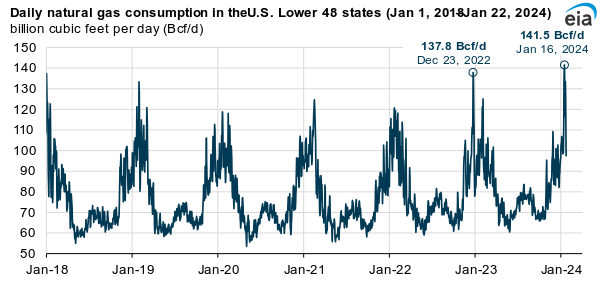Quick Takes and Random Stuff Feb 8, 2024
Diurnal temperature range, natural gas records, EVs, parsnips, crypto mining and more
Graph of the week
I’ve noticed that in Ithaca, NY, it seems that nighttime temperatures are more above average than daytime temperatures. I’ve been wondering if that was true in general or not. More technically, is “the diurnal temperature range (DTR), defined as the difference between the daily maximum temperature (Tmax) and daily minimum temperature (Tmin)” increasing or decreasing? This graph from the paper Reversed asymmetric warming of sub-diurnal temperature over land during recent decades (11/8/2023) answers the question.
The red dots are where the maximum daily temperature is increasing faster than the minimum daily temperature. In other words, the diurnal temperature range (DTR) is increasing. The blue dots are where the minimum daily temperature is increasing faster or the DTR is decreasing. There are some spatial patterns here.
Natural gas consumption hits a new high
The EIA provides this graph of daily natural gas consumption (2/6/2024) that shows that we set a new daily consumption record on January 16, 2024. This isn’t really surprising; as the population grows, we have more spaces that need to be heated. All we need is a good cold snap, and a record is set, but there are details worth noting here.
Well-below-normal temperatures caused by a large mass of arctic air that covered most of the continental United States increased demand of natural gas used for residential and commercial space heating and for electric power generation. Both consumption of natural gas and withdrawals from underground storage increased to record volumes because of the higher demand.
Our normal ability to produce natural gas wasn’t sufficient, and we had to withdraw natural gas from underground storage. We tend to forget that we can store natural gas for emergencies. Further, we also had to increase coal electricity generation.
Natural gas consumption in the L48 averaged above 130.0 billion cubic feet per day (Bcf/d) from January 14 through January 21, 2024, as arctic air pushed south into the United States, causing temperatures to fall. Extreme wind chills, freezing rain, and snowy conditions persisted from the Pacific Northwest into Texas and across the Northeast and mid-Atlantic. Residential and commercial natural gas consumption accounted for almost 49% of L48 consumption during that period, up from 42% during the start of January, as homes and commercial buildings used more natural gas for heating. Electricity generation also increased during that time, with natural gas-fired and coal-fired electricity generation increasing to meet increased demand.
The question I have is: can solar and wind really fill this type of need? Solar generation is already down in the winter. In an all-electric system, which is already suspect when it comes to heating, presumably we would already be using battery-stored energy during the winter. We would then need to draw even further on this battery storage system during a cold stretch. This would seem to require a very large buildout of both solar and wind generation capacity, along with a massive battery storage system. We are a long way from making this a reality. In other words, we’ll be burning fossil fuels for the foreseeable future.
Ford losing on EVs
All you really need to read is the headline of this article from Robert Bryce. But,
he also makes a good point here:
As I explained in the written testimony I submitted to the Senate Energy and Natural Resources Committee last month, EVs have always been a niche-market product, not a mass-market one. And that niche market is dominated by wealthy, white, male, liberal voters who live in a handful of heavily Democratic cities and counties.
We are a long way from replacing natural gas with electricity and from even 50% of vehicles on the road being fully electric.
Parsnips
You might think that I’m just a data nerd who spends his entire day in front of a computer. I decided to harvest my parsnips this past weekend. They are one of the more difficult vegetables to grow given the slow germination rate, their dislike of my NYS soil, and the fact that the voles like them too. Still, this was a good year with 30–40 pounds of parsnips.
Jobs for PhDs
The Chronicle of Higher Education article This Is Where New Ph.D.s Find Jobs (2/2/2024) has two enlightening charts. The first shows a large change in where some Ph.D. recipients are employed. Part of this is due to the lack of jobs in higher education.
On the other hand, don’t feel bad, as the pay is better than higher education pay. Keep in mind that this is median pay.
Stupid headline
Blatant sensationalism does the media no good. This headline from The Guardian is as good as it gets: Global shark bite deaths doubled in 2023 with 40% occurring in Australia. The data rule that large disparities warrant skepticism applies here. Wow, a doubling of deaths! Well, it is not hard to double a small quantity. Shark bite deaths rose from 5 in 2022 to 10 in 2023. Worse, we should also apply the data rule normalize properly; ask, “Per what?” To provide proper context here, we would also like to know if there was a change in the total time people spent in the ocean. For instance, it would be a concern if only 10 people entered the ocean in 2023 and sharks killed them all. Unfortunately, calculating people hours in the ocean is hard to do, but given that populations grow, it would be surprising if they went up, so some of the doubling is just normal growth. Don’t get sucked into the fear that a headline like this can generate. If you want to spend some time in ocean waters, don't be concerned about becoming a shark meal.
Crypto mining
Another chart from the EIA (2/1/2024)
Electricity demand associated with U.S. cryptocurrency mining operations in the United States has grown very rapidly over the last several years. Our preliminary estimates suggest that annual electricity use from cryptocurrency mining probably represents from 0.6% to 2.3% of U.S. electricity consumption.
It is a good thing we are adding all that solar and wind power so that we can mine cryptocurrency.
Vesuvius Challenge
The winner of the Vesuvius Challenge was announced recently.
Two thousand years ago, a volcanic eruption buried an ancient library of papyrus scrolls now known as the Herculaneum Papyri.
In the 18th century the scrolls were discovered. More than 800 of them are now stored in a library in Naples, Italy; these lumps of carbonized ash cannot be opened without severely damaging them. But how can we read them if they remain rolled up?
The challenge was simple: read the scrolls. It will be really interesting to see what we learn from now being able to read these scrolls. Go to the website to learn more and see some neat visuals.
The spinning CD
The Spiral Scouts: Setting Suns
Please share and like
Please help me find readers by forwarding this article to your friends (and even those who aren't your friends), sharing this post on social media, and clicking like. If you're on Twitter, you can find me at BriefedByData. If you have any article ideas, feedback, or other views, please email me at briefedbydata@substack.com.
Thank you
In a crowded media market, it's hard to get people to read your work. I have a long way to go, and I want to say thank you to everyone who has helped me find and attract subscribers.
Disagreeing and using comments
I'd rather know the truth and understand the world than always be right. I'm not writing to upset or antagonize anyone on purpose, though I guess that could happen. I welcome dissent and disagreement in the comments. We all should be forced to articulate our viewpoints and change our minds when we need to, but we should also know that we can respectfully disagree and move on. So, if you think something said is wrong or misrepresented, then please share your viewpoint in the comments.












